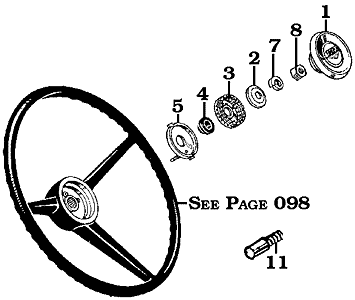- Thread starter
- #21
Thanks Coolerman. Your photo is correct, I have the Horn Seat and spring loaded contact in the horn. I Had to replace the Green / Red wire completely as it was not there. Soldered the end of the new to the metal contact ring (through the rubber bushing) and it is connected to the Horn Relay S terminal.You should NOT have any voltage on the GR wire! This wire GROUNDS when you push the horn button. Do you have the device shown in the pic below installed inside the column? The gizmo is the horn contact insulator bushing and sits on top of the column. It has a wire embedded in it that connects to the GR wire you ran to the horn relay S terminal. When you press the horn button the you are connecting the center contact plate (which is BOLTED to the steering shaft which MUST be grounded) to the horn contact brush which is riding on the horn contact insulator bushing which is attached to the GR wire going to the Horn Relay S terminal.
So... If you unplug the GR wire form the column and ground it the horns will blow right? So the ONLY thing that could possibly be wrong is the column SHAFT is not grounded via the rag joint, or your horn button assembly is not correct. I have a web page that goes into great detail about the exact order the parts have to be installed in. Horn Troubleshooting
Hang in there you will get it to work!
View attachment 1163565
Grounded the new wire by the horn ring and had a spark, now lost the power...I'll figure that one out, not to worry. Will check out your link.
Focusing on the Grounding of the Rag joint as this to me seems the most logical issue. Even though I grounded the steering nut and tried to blow the horn to no joy. I know what the Rag joint is and how to ground it via photos, but it is not exposed on my LC, as in the attached picture... Will get there but the journey is a choice curse dictionary


 )
)
 . I had to run a temporary power wire from the Horn fuse to Terminal B, but it operates!. However, connecting the horns to the relay and pressing the horn button, the relay locks up.
. I had to run a temporary power wire from the Horn fuse to Terminal B, but it operates!. However, connecting the horns to the relay and pressing the horn button, the relay locks up.  ?
?